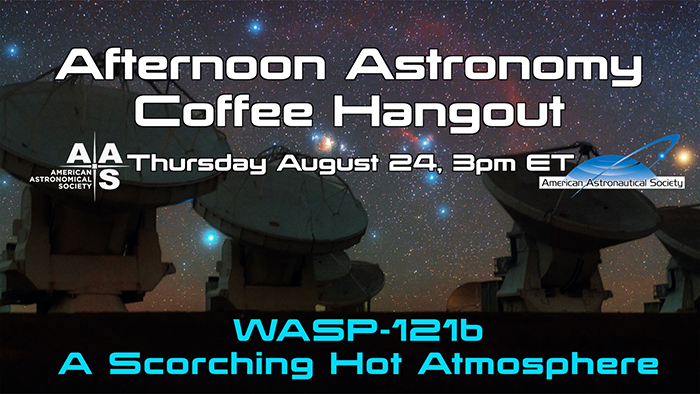Afternoon Astronomy Coffee Hangout 24 August
Carol Christian STScI
"WASP-121b - A Scorching Hot Atmosphere"
We know that for planets close to their parent stars, the temperature is very high and can heat and even dissipate atmospheres. For example, if the planetary atmosphere is retained and the starlight is able to penetrate deep into it, the gas is heated and radiated back into space as infrared light. A different scenario can occur if there are cooler molecules at the top of the atmosphere, like water vapor for example. In that case, the water vapor can prevent some radiation from getting back out and the water vapor starts to glow. A similar thing happens in the upper atmosphere of the Earth, but the molecule causing the heating is ozone. The layer that is hotter than the atmosphere below is called a stratosphere. On Wasp-121b, evidenced through Hubble observations, there seems to be such a layer, and with a temperature rising about 560 degrees Celsius. Usually an atmosphere would be cooler with higher altitude. The exact molecules causing this on Wasp-121b are a bit of a mystery, but this object represents a particular class of "Hot Jupiters."
Join regular hosts Tony Darnell and Carol Christian on Thursday, 24 August, at 3:00 pm ET as they chat with Tom Evans (Exeter College), Tiffany Kataria (NASA JPL), and collaborators about this very hot Jupiter-type planet and the observations they made (and will make!) of this object. The best place to hangout with us will be on YouTube, broadcast on the Deep Astronomy Channel. The direct link to view this hangout will also be posted on the Deep Astronomy Facebook page. During the hangout, you can take part in the live chat and join the conversation on Twitter with #AstroCoffee. An archive of previous hangouts in this series may be found in the Deep Astronomy YouTube playlist.
What Are "Afternoon Astronomy Coffee" and "Future in Space" Hangouts?
"Future In Space” and "Afternoon Astronomy Coffee" Hangouts are part of a weekly series, held every Thursday, that also includes a segment called "Footsteps to Mars." We bring the the latest research in astronomy, highlights from the future of space astronomy and astronautics planning, as well as updates on the exploration of Mars to you every week via Hangouts on Air. With the sponsorship of both the American Astronomical Society (AAS) and the American Astronautical Society (the other AAS), our hosts Tony Darnell, Carol Christian, Alberto Conti, and Harley Thronson examine today's breakthroughs in research and peer into the unfolding possibilities of what we may learn about the universe and Mars exploration. We join with members of the American Astronomical Society to chat, in an informal online setting modeled after "science coffee" events held in universities and research organizations across the country. We will examine what we hope to learn about exoplanets, black holes, the early universe, quasars, and life in the universe along with what technologies might help us — and reflect upon the scientific endeavors occurring today that uncover amazing astrophysics and lay the groundwork for studies to come.
We will also explore the technology and engineering used today as well as possibilities for future space travel and research with members of both societies, and probe what our future in space may look like and how we might get there. We will examine the underlying technologies of space telescopes, orbiters, landers, and human space vehicles now and in the years to come. We will delve into topics that help us understand the possibilities and limitations of human space flight and eventual human colonization of other worlds.
We hope you can join us each month as we bring experts from both societies — people who think about and plan for our future in space — to your computer, tablet, or smartphone. We invite you to bring your questions and comments and get ready to learn about the amazing possibilities for the future of space astronomy and exploration.


